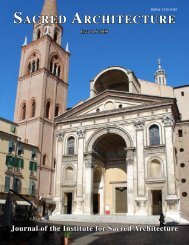Download Issue PDF - The Institute for Sacred Architecture
Download Issue PDF - The Institute for Sacred Architecture
Download Issue PDF - The Institute for Sacred Architecture
- No tags were found...
Create successful ePaper yourself
Turn your PDF publications into a flip-book with our unique Google optimized e-Paper software.
emoved. <strong>The</strong> restoration would be especiallysignificant in view of the long and bitterlegal battle over the Jesuits’ right to removemuch of the building’s interior. In1991 they won a precedent-setting rulingfrom the state Supreme Judicial Court,which held that it was unconstitutional <strong>for</strong>the city to regulate changes to a church interiorby declaring it a historic landmark.Mount Sinai is claimed to have beendiscovered at Mount Har Karkon, in the IsraeliNegeb desert. In his book, Mysteriesof Mount Sinai, Emmanuel Anati writes,“we found the altar and 12 boundary postsat the foot of the mount. Those 12 pillarsare mentioned in the pages of the Bible [Ex24:4]. <strong>The</strong>n, some 60 meters away, the remainsof a Bronze Age camp. This is alsomentioned in the Old Testament . . . In aprotruding commemorative burial moundwas an altar, and underneath, the vestigesof a fire. On the altar there was a whitestone in the shape of a half moon, the symbolof the moon god Sin.”Austrian archeologist Renate Pillingerof the University of Vienna revealed the discoveryin Ephesus of Christian cave paintingsrepresenting St. Paul. In 1995, a cavewas discovered a few kilometers away fromthe city’s ruins. Inside the cave, there arepaintings depicting the Transfiguration anda sequence inspired by the Acts of theApostles, refering to St. <strong>The</strong>cla and St.Paul’s preaching. Paul’s portrait is one ofthe best-preserved frescoes in the cave. It istoo early to state that the cave’s discoveryarcheologically confirms Paul’s presence inEphesus, which other sources, such as theBible, consider indisputable.<strong>The</strong> Basilica of the Agony in the Gardenof Gethsemani in Jerusalem wasrobbed in February. <strong>The</strong> robbery in the Basilicawas well planned. Two early twentiethcentury bronze deer were removed.<strong>The</strong> statues were life-size and located highin the tympanum of the building’s façadeat the foot of the cross.Cardinal Adam Maida plans to spend$20 million during the next three years todraw Detroit area Catholics back toBlessed Sacrament Cathedral in Detroit.Renovation plans include the addition of anew glass-and-steel wing to the north sideof the neo-Gothic church. <strong>The</strong> wing willbe near the main altar and flood the centerof the gray limestone building with sunlight.To meld the old with the new, anenormous stained-glass window will besuspended in the heart of the new wing.Stone arches around the altar will be trans<strong>for</strong>medby curving metal-mesh sheets to<strong>for</strong>m a multilayer abstract backdrop <strong>for</strong>the Mass. Seating will expand from 800 to1,200. Much of the renovation budget isset aside <strong>for</strong> repairs. <strong>The</strong> badly-needed replacementof the roof is almost finished.Archdiocesan officials and architectGunnar Birkerts are finalizing buildingplans and deciding where a redesigned altar,pulpit and archbishop’s chair will beplaced. <strong>The</strong> major portion of the new constructionis expected to begin in May 2001and end by early 2003.Fr. Rasko Radovic, parish priest of theSerbian community of Trieste, in Italy, denouncedthe destruction by Albanians ofmore than 80 Orthodox churches andmonasteries in Kosovo, since the arrival ofthe U.N. administration. Some of thebuildings dated back to the 13th century<strong>The</strong> $65 million Pope John Paul II Cultural Center in Washington, D.C. is expected toopen in November.N E W Sand were part of a considerable artistic andcultural heritage. Fr. Radovic said he didnot understand why the UNESCO, whichwas so active during the Balkans War, hasremained silent.CONFERENCES &EXHIBITIONSReconquering <strong>Sacred</strong> Space 2000: <strong>The</strong>Church in the City of the ThirdMillenium will be held at the PontificalUniversity of St. Thomas Aquinas in Rome,Italy, December 1 and 2, 2000. <strong>The</strong> conferencewill include lectures by an internationalgroup of architects, theologians, andhistorians on the contemporary renaissanceof Catholic architecture. An exhibition onnew traditional Catholic churches will beheld at Palazzo Valentini December 1-20,and a catalog of the exhibition will be publishedby Il Bosco e la Nave. <strong>The</strong> conferenceand exhibition is being sponsored by theAgenzia per la Citta, publisher Il Bosco e laNave and the <strong>Institute</strong> <strong>for</strong> <strong>Sacred</strong> <strong>Architecture</strong>.For in<strong>for</strong>mation please contactdstroik@nd.edu or roscri@flashnet.it.Peter and Paul: History, Devotion, andMemories of the First Centuries, is an exhibitionrunning from June 30 until December10, 2000 at the Cancelleria Palace inRome. It will focus on the time when thetwo apostles were in Rome. <strong>The</strong> exhibitionwas organized by the Pontifical Council <strong>for</strong>the Laity and the Directorate of Monumentsof Vatican City. Heavy assistance iscoming from the Friendship Meetingamong Peoples, an organization which ispart of the ecclesial movement Communionand Liberation, which <strong>for</strong> years has organizedtravelling exhibitions on historicaltestimonies of the faith. Vestiges from thecatacombs and basilicas: commemorativetablets, sarcophagi and gilded glass aresome of the items on display. Objects werechosen to reflect the life and motivations ofearly Christians: their relations with thepre-existing Jewish community in Rome;their confrontation with the polytheistworld; their vision of the beyond; movingtestimonies that, as Francesco Buranelli, directorof the Vatican Museum recalled, revealhow the devotion to martyrs was alreadydeeply rooted. <strong>The</strong> Eternal Cityowes virtually everything to Peter andPaul, explained Archbishop CrescenzioSepe, secretary of the Vatican Jubilee Committee.“Without the message of these twoapostles, the history of this city would haveended, in all probability, at the end of theRoman Empire. Indeed, without knowingPeter and Paul, one cannot understand allthe signs that the Church has left in streetsand squares of the city of Rome.”<strong>Sacred</strong><strong>Architecture</strong> Fall 2000 7Photo by James McCrery










